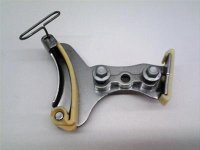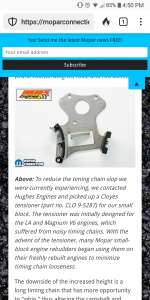Does10s awesome post on the "one link less" reversed SBF Double Roller timing chain set was a delight.
viewtopic.php?f=5&t=58314&p=447439&hilit=SBF+Timing#p447439
Seams everyone who really hits the drag scene with the US 250 seams to have inconsistancy and reliablity issues due to what I believe is cam timing scatter. Its not a big feature of the US 144/170/200 or Aussie or Argentine 188/221/250 engines, as the bigger Aussie and Argie engines got better wider link belts with a tight pitch.
So I got to thinking...


The US HSC 2300 and 2500 are thechnically not 3300/200 CID I6 based fours at all, as they use the US/Australian 221/250 cam positioning. The main bearings are 250 sized, and nothing from the 3.3 fits the 2.3 or 2.5, as the 4 cylinders rods, crank stroke are all different. Not sure on the oil pump.
Fours vibrate badly in line north south set ups, which is why you never saw HSC 2300/2500's in rear drive situations. In FWD, West East situations, all the vibes can be largely dampened out using the existing mounts. The timing chain though is still under imense stress, so you may be interested to know the HSC Timing chain isn't Aussie or US 221/250 based, but has been upgraded to a very special 46 link, 0.5" pitch item with 17 teeth on the crank and 34 on the cam. And a really good tensioner. Not at all like the 200 and 250, and the water pump has been placed on the side of the block, so the 2.3/2.5 has lots of space for the tensioner, which is taken up with the front mounted water pump on the small sixes.
I'd like to ask someone with a US 250. Bearing in mind how bad the stock 56 link 1 and 0.625" wide 42/21 teeth system is, wouldn't a used or new HSC Tempo or 2.5 Taurus item just bolt on and fix all the problems. Any one willing to have a go?
Same with the N code 6 inch 2500 HSC rods found on 1986 to 1990 FWD Fords with the 153 cube 2.5 liter engine ...likely to be a straight bolt in to the US 250, perfect to the thousandth to correct the 89 to 120 thou short fall of the 1.531" inch piston from the top of the 9.469" block with the 3.91" stroke.
Those Autoplus timing chain specs cover the Aussie, German Cologne and American engines from 1984 to 2000 ish, and are found in http://autoplus-tk.com/pages/fd.htm
If I'm not mistaken, the key kit is the same between the 8.66" deck 2.3 and 9.38" deck 2.5. Yes, they use the same cam to crank spacing as each other....and the 9.469" deck US 250 and 8.425 and 9.38" Aussie 188-221/250!
HSC 2300 (140) R,S or X code 84~94 FORD, LINCOLN/MERCURY
HSC 2500 (153) N code 86~92 FORD, LINCOLN/MERCURY
Cam Sprocket TK-FD203-A01, 46Link Timing chain TK-FD203-A03 1 Crank Sprocket TK-FD203-A02.
viewtopic.php?f=5&t=58314&p=447439&hilit=SBF+Timing#p447439
Seams everyone who really hits the drag scene with the US 250 seams to have inconsistancy and reliablity issues due to what I believe is cam timing scatter. Its not a big feature of the US 144/170/200 or Aussie or Argentine 188/221/250 engines, as the bigger Aussie and Argie engines got better wider link belts with a tight pitch.
So I got to thinking...


The US HSC 2300 and 2500 are thechnically not 3300/200 CID I6 based fours at all, as they use the US/Australian 221/250 cam positioning. The main bearings are 250 sized, and nothing from the 3.3 fits the 2.3 or 2.5, as the 4 cylinders rods, crank stroke are all different. Not sure on the oil pump.
Fours vibrate badly in line north south set ups, which is why you never saw HSC 2300/2500's in rear drive situations. In FWD, West East situations, all the vibes can be largely dampened out using the existing mounts. The timing chain though is still under imense stress, so you may be interested to know the HSC Timing chain isn't Aussie or US 221/250 based, but has been upgraded to a very special 46 link, 0.5" pitch item with 17 teeth on the crank and 34 on the cam. And a really good tensioner. Not at all like the 200 and 250, and the water pump has been placed on the side of the block, so the 2.3/2.5 has lots of space for the tensioner, which is taken up with the front mounted water pump on the small sixes.
I'd like to ask someone with a US 250. Bearing in mind how bad the stock 56 link 1 and 0.625" wide 42/21 teeth system is, wouldn't a used or new HSC Tempo or 2.5 Taurus item just bolt on and fix all the problems. Any one willing to have a go?
Same with the N code 6 inch 2500 HSC rods found on 1986 to 1990 FWD Fords with the 153 cube 2.5 liter engine ...likely to be a straight bolt in to the US 250, perfect to the thousandth to correct the 89 to 120 thou short fall of the 1.531" inch piston from the top of the 9.469" block with the 3.91" stroke.
Those Autoplus timing chain specs cover the Aussie, German Cologne and American engines from 1984 to 2000 ish, and are found in http://autoplus-tk.com/pages/fd.htm
If I'm not mistaken, the key kit is the same between the 8.66" deck 2.3 and 9.38" deck 2.5. Yes, they use the same cam to crank spacing as each other....and the 9.469" deck US 250 and 8.425 and 9.38" Aussie 188-221/250!
HSC 2300 (140) R,S or X code 84~94 FORD, LINCOLN/MERCURY
HSC 2500 (153) N code 86~92 FORD, LINCOLN/MERCURY
Cam Sprocket TK-FD203-A01, 46Link Timing chain TK-FD203-A03 1 Crank Sprocket TK-FD203-A02.









